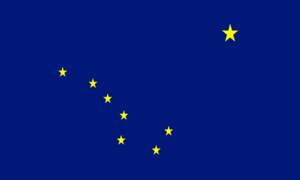The Alaska flag truly does have an interesting history. Although the Alaska flag was not adopted for official state use until 1959, it was actually created much earlier– in 1926.

The Alaska Flag of consists of eight gold stars, that together form the Big Dipper and the North Star, all emblazoned upon a dark blue field. The first seven of the stars on the Alaska Flag are supposedly from the constellation Ursa Major (the Big Dipper). The eighth star on the Alaska Flag represents the North Star, symbolizing Alaska’s being the northern most state. The blue field of the Alaska Flag represents the sky, the sea and mountain lakes, and also Alaska’s wildflowers.
The Alaska flag was designed in 1927 by a 13-year-old Native American boy named Bennie Benson, who resided in Seward. There was a contest established to create a flag for Alaska- what was then simply the “Alaska Territory”. Benson’s design for the Alaska Flag was chosen over roughly 700 other submissions from schoolchildren ranging from grades 7-12 territory-wide.
In celebration of his achievement, Benson was awarded $1,000 along with an engraved watch. Most of the other students’ entries featured variations on the traditional territorial seal, the midnight sun, northern lights, polar bears, and others of the like.
Until this time, Alaskans had generally flown only the U.S. flag since the territory was purchased from Russia in 1867, however the Alaska Legislature soon adopted Benson’s Alaska Flag design. Benson’s Alaska Flag design became the official Alaska Flag for the Territory of Alaska on May 2, 1927. The very first flag made based on Benson’s design was made of blue silk and gold stars, and was inaugurally flown on July 9, 1927. Benson’s original design for the Alaska Flag was retained as the official Alaska State Flag upon declaration of statehood in 1959.
